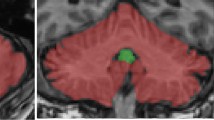Abstract
Purpose
Prolonged latency of visual evoked potentials (VEP) has been used to identify clinically silent lesions in multiple sclerosis (MS) suspects. The objective of this study was to determine the reliability of VEP to predict the development of MS in MS suspects.
Methods
Retrospective hospital records of MS suspects were evaluated. VEP was analyzed together with subsequent diagnostic confirmation of MS by McDonald diagnostic criteria for MS-2005.
Results
MS developed in 12 of 35 patients (34 %) and 23 (66 %) failed to exhibit diagnostic characteristics. P100 latencies and interocular latency differences were longer in clinically definite multiple sclerosis (CDMS) than non-CDMS patients (p = 0.002, 0.001, respectively). All patients in the subsequent MS group had P100 latencies longer than102 ms, a mean of our MS-free subjects thus providing 100 % of sensitivity. No patient developed MS with a P100 latency <102 ms. Brain MRI lesions associated significantly with developing CDMS (p = 0.001). Predictability of developing CDMS was highest when criteria for P100 latency, interocular latency difference, and brain MRI lesions were combined.
Conclusion
MS suspects with a P100 latency longer than mean of MS-free subjects are more likely to develop MS than those with lower values. VEP latency combined with MRI could improve the accuracy of MS prediction.


Similar content being viewed by others
References
Polman CH, Reingold SC, Edan G, Filippi M, Hartung HP, Kappos L, Lublin FD, Metz LM, McFarland HF, O’Connor PW, Sandberg-Wollheim M, Thompson AJ, Weinshenker BG, Wolinsky JS (2005) Diagnostic criteria for multiple sclerosis: 2005 revisions to the “McDonald Criteria”. Ann Neurol 58(6):840–846. doi:10.1002/ana.20703
Beer S, Rosler KM, Hess CW (1995) Diagnostic value of paraclinical tests in multiple sclerosis: relative sensitivities and specificities for reclassification according to the poser committee criteria. J Neurol Neurosurg Psychiatry 59(2):152–159
Filippini G, Comi GC, Cosi V, Bevilacqua L, Ferrarini M, Martinelli V, Bergamaschi R, Filippi M, Citterio A, D’Incerti L et al (1994) Sensitivities and predictive values of paraclinical tests for diagnosing multiple sclerosis. J Neurol 241(3):132–137
Lee KH, Hashimoto SA, Hooge JP, Kastrukoff LF, Oger JJ, Li DK, Paty DW (1991) Magnetic resonance imaging of the head in the diagnosis of multiple sclerosis: a prospective 2-year follow-up with comparison of clinical evaluation, evoked potentials, oligoclonal banding, and CT. Neurology 41(5):657–660
Rot U, Mesec A (2006) Clinical, MRI, CSF and electrophysiological findings in different stages of multiple sclerosis. Clin Neurol Neurosurg 108(3):271–274. doi:10.1016/j.clineuro.2005.11.021
Gronseth GS, Ashman EJ (2000) Practice parameter: the usefulness of evoked potentials in identifying clinically silent lesions in patients with suspected multiple sclerosis (an evidence-based review): report of the quality standards subcommittee of the American Academy of Neurology. Neurology 54(9):1720–1725
Hume AL, Waxman SG (1988) Evoked potentials in suspected multiple sclerosis: diagnostic value and prediction of clinical course. J Neurol Sci 83(2–3):191–210
Matthews WB, Wattam-Bell JR, Pountney E (1982) Evoked potentials in the diagnosis of multiple sclerosis: a follow up study. J Neurol Neurosurg Psychiatry 45(4):303–307
Grover LK, Hood DC, Ghadiali Q, Grippo TM, Wenick AS, Greenstein VC, Behrens MM, Odel JG (2008) A comparison of multifocal and conventional visual evoked potential techniques in patients with optic neuritis/multiple sclerosis. Doc ophthalmol 117(2):121–128. doi:10.1007/s10633-007-9112-7
Klistorner A, Fraser C, Garrick R, Graham S, Arvind H (2008) Correlation between full-field and multifocal VEPs in optic neuritis. Doc ophthalmol 116(1):19–27. doi:10.1007/s10633-007-9072-y
Matthews WB, Small DG, Small M, Pountney E (1977) Pattern reversal evoked visual potential in the diagnosis of multiple sclerosis. J Neurol Neurosurg Psychiatry 40(10):1009–1014
Paty DW, Oger JJ, Kastrukoff LF, Hashimoto SA, Hooge JP, Eisen AA, Eisen KA, Purves SJ, Low MD, Brandejs V et al (1988) MRI in the diagnosis of MS: a prospective study with comparison of clinical evaluation, evoked potentials, oligoclonal banding, and CT. Neurology 38(2):180–185
Diem R, Tschirne A, Bahr M (2003) Decreased amplitudes in multiple sclerosis patients with normal visual acuity: a VEP study. J clin neurosci 10(1):67–70
Mizota A, Asaumi N, Takasoh M, Adachi-Usami E (2007) Pattern visual evoked potentials in Japanese patients with multiple sclerosis without history of visual pathway involvement. Doc ophthalmol 115(2):105–109. doi:10.1007/s10633-007-9062-0
Adachi-Usami E (2006) Aging and pattern visual evoked cortical potential. In: Heckenlively JR, Arden GB (eds) Principles and practice of clinical electrophysiology of vision, 2nd edn. MIT press, London, pp 361–367
Acknowledgments
We would like to thank Ms. Julaporn Pooliam, MS.C for the statistical calculations ,and Dr. William Beamish in reviewing of this manuscript.
Conflict of interest
The authors declare that there is no conflict of interest.
Ethical standard
The Institutional Review Board of Siriraj Hospital.
Author information
Authors and Affiliations
Corresponding author
Rights and permissions
About this article
Cite this article
Chirapapaisan, N., Laotaweerungsawat, S., Chuenkongkaew, W. et al. Diagnostic value of visual evoked potentials for clinical diagnosis of multiple sclerosis. Doc Ophthalmol 130, 25–30 (2015). https://doi.org/10.1007/s10633-014-9466-6
Received:
Accepted:
Published:
Issue Date:
DOI: https://doi.org/10.1007/s10633-014-9466-6




